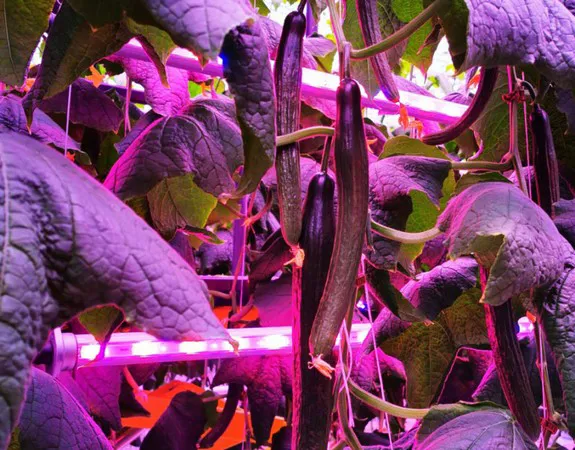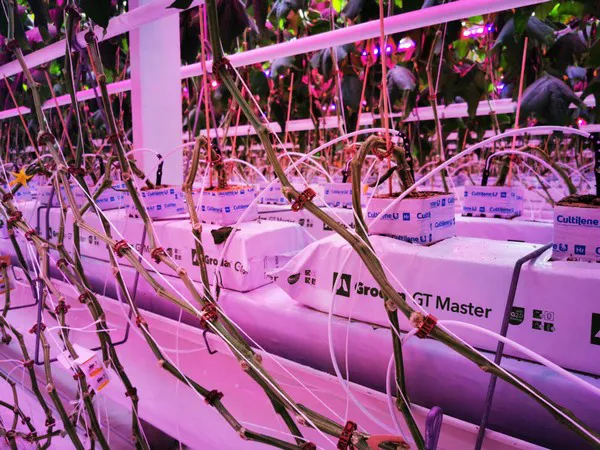On 24 May 2017, Getlini EKO opened the their first cucumber greenhouse where LED lighting is used as a source of light assimilation. From day one, a widely used method, fruit rationing, was used in Getlini EKO to grow cucumbers, leaving only as much fruit as possible to grow in the planned amount of light.
According to calculations, the weekly yield in Getlini EKO should not be less than 4.2 kg/m2; respectively, at a plant density of 3.56 plants/m2 and the planned average fruit weight of 260 grams, not less than 4 and not more than 5 cucumbers should be collected from a plant. To achieve this number of fruits, in the weeks when the plant produces 7 leaves, the formed fruit must be removed from 2 leave partings.

The first cycle of cucumbers took place as a training, during which the employees learnt their working methods and perfected their professional skills so that they could work at full capacity in the next cycle. It became clear during this cycle that even a greenhouse as well-equipped as the new cucumber greenhouse in Getlini EKO does not measure such important things like: how the plants feel and how they react to changes in temperature and air humidity.
Need for the climate and plant measurements
The second cucumber cycle in 2017 already took less time, but the need to measure the plants themselves, and not the climate within the greenhouse alone, became even more evident. This view was supported by the fact that, inexplicably, what had worked at SGGW, did not work at Getlini EKO, as the plants were transpiring less water, and even though the relative number of fruits was sufficient, some of the fruits stopped growing at some point. It was specifically the stopping of fruit growth that caused the failure to meet the planned harvest rates in 2017.
It is worth pointing out that in 2017 the scope of equipment for monitoring plants was limited and its price was disproportionate to the yield in addition to the fact that the level of knowledge in using it was very low. Inquiries revealed SAF Tehnika – the company right here, in Latvia, that makes wireless sensors, under brand name Aranet, for measuring temperature and humidity.

The first Aranet base station was set up at Getlini EKO in January 2018, equipped with the sensors available at the time to measure ambient temperature, relative air humidity and the level of CO₂. The temperature sensors were installed at different heights: at the top end of the plant, in the midsection and at the bottom, where the fruit is. That helped us realize that our previous assumptions and understanding of heat behavior within the greenhouse had been incomplete. It turned out that on a sunny day the temperature differential between the top end of the plant and the part where the fruit is can be up to 2 degrees. As the top end is warmer, it is developing faster than the fruit. While in winter, with the full heating on, the air around the fruit is up to 3 degrees hotter than the air at the top. As the ambient temperature changes, so does the relative air humidity, the capacity of the plants to transpire water and ultimately also the water consumption.
Setting these sensors up at the same height in different locations of the relatively small greenhouse revealed that the ambient temperature can fluctuate by 2.5 degrees. This factor must be taken into account in grading the fruits. In the cooler end of the greenhouse, the temperature drop was 1.5 degrees at night and up to 2.5 degrees during the day, resulting in lower growth rates there, which meant that more fruits would have to be left to maintain an equal yield thought the greenhouse. Despite the various issues, the first winter/summer cycle, which takes place between 13 January and 6 July, yielded 287 fruits or 71.8 kg/m2.
With the training that started during the 2018 winter/summer cycle, the same cycle in 2019 led to a harvest as high as 315 fruits/84.2 kg/m2.
The harvest rates achieved at Getlini EKO this year come from careful data analysis, of monitoring and managing the plants. This result is a consequence of small changes in many parameters and operating methods, taking into account the reactions of the plant and providing it with all its needs. This makes it a precision method for growing cucumbers, which can help a responsible agriculturist like Guntars Strauts to achieve even better results.
You need to know the amount of light
One can also point out that such methods are only useful in greenhouses as advanced as the one in Getlini EKO, though it is not exactly true. Unlike, say, common plastic film greenhouses, at the Getlini EKO greenhouse you can control every climate parameter, and for all these options, Getlini EKO could not fulfill its production plans by growing its plants without monitoring their reactions to change.
Monitoring plant growth in this manner is simple and easy to understand. It can be of value to the owners of typical plastic film greenhouses that are rather common in Latvia.
When using this approach in a greenhouse without artificial lighting, and whenever a prolonged reduction in the total amount of light is expected, it is recommended to pick smaller fruits, thus relieving the plant and giving it reserves for maintaining its roots and growing new fruits, thus preventing fruit abortions. Our observations show that a reduction in the 24-hour average temperature does not result in a proportional reduction in plant growth. By monitoring your greenhouses, you can determine when the time is right to start picking smaller fruits.
Monitoring plant growth can also be valuable in greenhouses where soil is used as a growing medium, because knowing the growth rate makes it possible to determine the time to water the plants: a deficit of water causes a significant reduction in the growth rate of the plant, and it is important to water the plants before they start losing weight.
Lighting is the biggest limiting factor. Total light is less used as a parameter in open-field agriculture, where total temperature is more important. When growing plants in greenhouses, one must know the total light they receive, because unlike the plants grown in fields which are harvested at the end of the growth cycle, greenhouse plants, such as cucumbers, undergo multiple harvests during the growth cycle, meaning that the total light is a more important parameter in determining productivity. Even in a common plastic film greenhouse, it is enough to monitor total light compared to its yield for a couple of weeks to realize that the total light parameter can be used to predict productivity.
For more information:
Aranet
www.aranet.com
info@aranet.com
